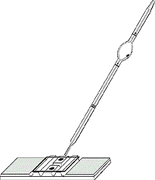The various systems used for counting chambers differ in the design of the counting net and the chamber depth. The counting net is made up of a square net division which is not visible until it is placed under a microscope (approx. 100 times magnification).
- Largest square size : 1 mm�
- Group square : 0,04 mm�
- Smallest square size : 0,025 mm�
Depth of chamber is 0.100 mm. The net division of these chambers has 3 times 3 large squares, each with an area of 1 mm�
The four corner squares are used for leucocyte counts.
The large square in the middle is also divided into five times five group squares with an edge length of 0.2 mm each and an area of 0.04 mm2 each. The group squares in turn are divided into sixteen very small squares each with an area of 0.0025 mm2
Five of these group squares are used for erythrocyte counts.
Special attention should be given to the fact that the chamber has triple lines on all sides, of which the central line is to be regarded as the actual dimension line. This is important for deciding whether cells in the border area are to be counted or not.
|




